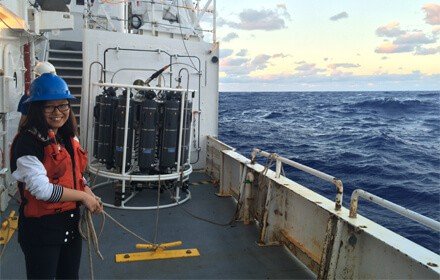Researchers recently discovered a new process for the slow removal of old carbon from the oceans. The discovery was published in Science Advance, by a team of scientists including Dr. David Keiber, Distinguished Professor in the College of Environmental Science and Forestry’s (ESF) Department of Chemistry.
The discovery helps to solve a long-standing mystery as to where ancient marine organic matter is destroyed or disappears.
“Carbon cycles through the biosphere effortlessly between the living and nonliving,” said Kieber, “but the carbon cycle can occasionally get stuck.” Sometimes carbon produced by plants is transformed by fungi and bacteria into organic matter that can no longer be used by organisms and this carbon grows old.
“Really old,” said Kieber, “on the order of thousands of years old.”
The ocean is full of this old carbon. More than 95 percent of the total amount of organic carbon in the oceans is old, and on a global scale, this oceanic reservoir of old carbon is comparable to the total amount of carbon tied up in plants on land and carbon dioxide in the atmosphere.
“This old carbon, produced by living organisms long ago, persists in the oceans much longer than the time scale for mixing of water between the surface and deep oceans by the global oceanic conveyor belt,” Kieber explained. “Since this carbon is so long-lived, the processes whereby it’s lost or removed from the oceans are necessarily extremely slow and therefore difficult to identify and trace.”
In the Sciences Advances paper, the team discovered a new process for the slow removal of old carbon from the oceans. Breaking waves at the ocean’s surface produce bubbles, and as they rise to the sea surface they are rapidly coated with organic matter. When the bubbles burst at the ocean’s surface, they inject some of this organic matter and sea salt into the atmosphere as little particles called aerosols.
“This newly discovered process improves our understanding of how carbon cycles in the biosphere between the living and nonliving,” said Kieber, “but perhaps most importantly these aerosols and the old carbon associated with them, especially the really small one in the 0.1 micron diameter range persist in the atmosphere for days to weeks, during which time they are exposed to sunlight and react with chemicals, which is thought to change some of this old, fossil carbon into forms that can be used by organisms once the aerosols deposit back onto land or into the sea.
Through this coupled ocean-atmosphere process, the old carbon re-enters the active carbon cycle. Not only is this process important for the carbon cycle, but more importantly removes the atmospheric transformation of these marine aerosols. This old carbon may play an important role in affecting climate and the earth’s radiation balance on a global scale both indirectly through the formation of clouds and indirectly by scattering of solar radiation by these aerosols, said Kieber.
Along with Kieber, the team included ESF alumni and a current student. This study was led by Dr. Steven Beaupre (’99 BS), assistant professor at SUNY Stony Brook, along with colleagues from several universities, and two former Ph.D. students from Kieber’s laboratory, Drs. Joanna Kinsey (’14, Ph.D.) and Yuting Zhu (’18, Ph.D.), and current graduate student John Bisgrove (environmental resources engineering).


